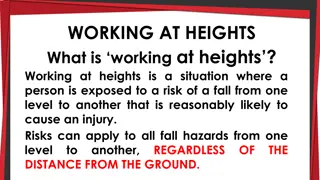
Essential Tips for Working Safely at Height Using Ladders and Steps
Learn key guidelines for safe work at height involving ladders and steps. Understand when to use them, how to assess risks, and ensure stability for a secure working environment.
Download Presentation

Please find below an Image/Link to download the presentation.
The content on the website is provided AS IS for your information and personal use only. It may not be sold, licensed, or shared on other websites without obtaining consent from the author. If you encounter any issues during the download, it is possible that the publisher has removed the file from their server.
You are allowed to download the files provided on this website for personal or commercial use, subject to the condition that they are used lawfully. All files are the property of their respective owners.
The content on the website is provided AS IS for your information and personal use only. It may not be sold, licensed, or shared on other websites without obtaining consent from the author.
E N D
Presentation Transcript
Working at Height from Ladders & Steps A Toolbox Talk covering the use of Ladders, Steps and associated Work at Height Equipment
Work at Height means work in any place where, if there were no precautions in place, a person could fall a distance liable to cause personal injury. Take a sensible approach to working at height. There may be some low- risk situations where common sense tells you no particular precautions are necessary, the law recognizes this. What is Work at Height?
There is a common misconception that ladders and stepladders are banned, but this is not the case. There are many situations where a ladder is the most suitable equipment for working at height. For tasks of low risk or short duration, ladders and step ladders can be a sensible option. Are ladders & step ladders banned? Remember - Take a sensible approach to working at height. There may be some low- risk situations where common sense tells you no particular precautions are necessary, the law recognizes this. Source HSE indg 344, 401, 455
As a guide, if your task would require staying up a leaning ladder or stepladder for more than 30 minutes at a time, it is recommended that you consider alternative equipment. What is Short Duration Work? Source HSE indg 344, 401, 455
The guidance from the HSE leaves this to your judgment but do allude to examples such as Starting a Screw , Hanging Wallpaper , Installing a Smoke Detector etc. Using these examples should provide an idea of what you may define as Low risk. What is Low Risk? Source HSE indg 344, 401, 455
Ladders and steps needs to be Level Stable Ladders need to be secured (where it is reasonably practicable to do so). You should only use ladders and steps in situations where they can be used safely. You can source ladders or accessories that can help make your ladder meet these requirements Check all four stepladder feet are in contact with the ground and the steps are level Source HSE indg 344, 401, 455
When deciding if it is safe to carry out a particular task on a stepladder where you cannot maintain a handhold (eg to put a box on a shelf, hang wallpaper, install a smoke detector on a ceiling), this needs to be justified, taking into account: The height of the task Whether a handhold is still available to steady yourself before and after the task Whether it is light work Whether it avoids side loading Whether it avoids overreaching Whether the stepladder can be tied (e.g. when side-on working) Step Ladders Source HSE indg 344, 401, 455
A study by the HSE has shown sideways tipping accounts for 40% of stepladder accidents. However, there are occasions when a risk assessment may show it is safer to work side on, eg in a retail stock room when you can t engage the stepladder locks to work face on because of space restraints in narrow aisles, but you can fully lock it to work side on. Step Ladders 3 Positioning and working Side on Try to avoid work that imposes a side loading, such as side-on drilling through solid materials (e.g. bricks or concrete) Where side-on loadings cannot be avoided, you should prevent the steps from tipping over. If you cannot secure the step you need to consider using a more suitable type of access equipment such as a podium step. Try to position the stepladder to face the work activity and not side on. Source HSE/GPSD 2009 Safety of Ladders report / HSE indg 344, 401, 455 /
Check all four stepladder feet are in contact with the ground and the steps are level. Some step ladders may have stability solutions built in to help adjust the step on uneven ground surfaces Only carry light materials and tools and consider a tool belt or a steps with a built in work tray. Don t overreach Step Ladder Stability Little Giant Select Steps can work on stairs and adjust to different heights reducing the risk of overreaching. Source HSE/GPSD 2009 Safety of Ladders report / HSE indg 344, 401, 455
Dont stand and work on the top three steps (including a step forming the very top of the stepladder) unless there is a suitable handhold. Can I stand on the Platform of a Platform Step? Here you can stand on the platform as the parapet or continuous handrail provides a suitable handhold and third point of contact. The red line indicates this is the highest tread you can work from on a Swingback or Builders type step. Source HSE indg 344, 401, 455 /
Maintain three points of contact at the working position. This means two feet and one hand, or when both hands need to be free for a brief period, two feet and the body supported by the stepladder. Where two hands need to be free for a brief period for light work. Keep two feet on the same step and the body (knees or chest) supported by the stepladder to maintain three points of contact. You can use both hands for brief periods on a step ladder! Knee Bar or continuous Handrail provides a third point of contact for the Knee or Thigh area and a safe handhold as required. Large working platform shows space for both feet Make sure a safe handhold is available. Source HSE indg 344, 401, 455
Employees have general legal duties to take reasonable care of themselves and others who may be affected by their actions, and to co-operate with their employer to enable their health and safety duties and requirements to be complied with. For an employee, or those working under someone else s control, the law says they must: Report any safety hazard they identify to their employer; Use the equipment and safety devices supplied or given to them properly, in accordance with any training and instructions (unless they think that would be unsafe, in which case they should seek further instructions before continuing). Users responsibilities Source HSE indg 344, 401, 455
Employers need to make sure that any ladder or stepladder is both suitable for the work task and in a safe condition before use. As a guide, only use ladders or stepladders that: Have no visible defects. They should have a pre-use check each working day Have an up-to-date record of the detailed visual inspections carried out regularly by a competent person. These should be done in accordance with the manufacturer s instructions Are suitable for the intended use, ie are strong and robust enough for the job Employers responsibilities Source HSE indg 344, 401, 455






















